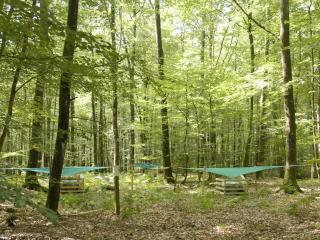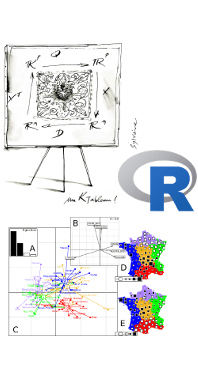Quantitative and Evolutionary Ecology of Communities Group
Members

Doctorante
UCBL

Professeure des universités
VetAgro-Sup
Tel: 33 04 72 43 27 56

Directeur de recherche
CNRS
Tel: 33 04 72 43 27 57

Doctorant
UCBL
Tel: 04 72 44 81 42

Doctorant
CNRS
Tel: 04 72 44 81 42
Doctorant
VetAgro-Sup

Post-doc
CNRS

Maître de conférences
UCBL
Tel: 04 72 44 81 42


Professeur des universités
UCBL
Tel: 33 04 72 43 27 56

Professeur des universités
UCBL

Directeur de recherche
CNRS
Tel: 33 04 72 43 27 56

Maîtresse de conférences
UCBL
Tel: 33 04 72 43 29 02
Maître de conférences
UCBL
Tel: 33 04 72 43 29 02

Our research activities, focused on interspecific interactions (community ecology), aim to better understand the ecological and evolutionary processes structuring species assemblages and biodiversity at different temporal and spatial scales. Our team addresses these major issues using contrasting biological models (communities of large African mammals, insects, microbiota, plants) from 3 complementary angles:
- Our work is strongly anchored in the conceptual framework of evolutionary biology by studying (i) the diversity of adaptive responses implemented by organisms to selective pressures in their environment, (ii) their consequences on population demography and ultimately (iii) the dynamics and composition of species communities.
- Our research is closely linked to societal issues of biodiversity conservation and management by integrating both the functioning of socio-ecological systems and the context of climate change. We conduct experimental studies, manage and ensure the long-term monitoring of several community observation networks.
- Methodological issues also occupy a central place in our team, with the development of new tools for statistical processing and modeling of ecological data. This activity leads to the development of methods and software that we develop and distribute freely.
Research programs

Functioning of African savanna communities
The Hwange LTSER (Long-Term Socio-Ecological Research site in Zimbabwe hosts a long-term interdisciplinary research program that focuses on the functioning of plant and animal communities within the Hwange National Park and the interactions between this protected area and humans living in its periphery. Based on this program, three axes are developed: (1) studying the population dynamics of elephants, exploring their impact and that of management policies on the socio-ecosystem functioning; (2) Understanding the extent to which interactions within and between trophic levels are sensitive to management actions (e.g. sport hunting, water management) and climate change; (3) Decoding human ecology and human-wildlife coexistence mechanisms towards integrated conservation and sustainable functioning of the socio-ecosystem. This research is complemented by more recent works in the Hluhluwe-iMfolozi Park and in the Madikwe reserve in South Africa, which focus on the role of environmental conditions on the hunting success of large African carnivores. We work in close collaboration with the IRL (International Research Lab) Rehabs.
Involved group members : Alice Bernard, Laura Lacomme, Aïssa Morin, Lisa Nicvert, Elie Pedarros, Yolan Richard, Marion Valeix*

Masting and the community dynamics of seed consumers
Masting is a reproductive strategy often encountered in perennial plants, characterized by fructifications highly fluctuating in time and being synchronized at the population level. The seeds produced that way constitute a pulsed resource with a strong impact on the eco-evolutionary dynamics of seed-consuming communities and forest regeneration. Our lack of knowledge of this system still impedes our understanding of the dynamics of temperate forest ecosystems and its future in the context of climate change. Our work carried out on oak forests aims to better understand (i) the proximal causes of masting, (ii) the mechanisms underlying the coexistence of species competing for such highly fluctuating resource and (iii) the co-evolution of consumer exploitation strategies for the fluctuating resource and forest tree fruiting strategies. On the basis of the results obtained, scenarii will be proposed on the future of forest regeneration under climate change, that may serve forest management.
Involved group members : Marie-Claude Bel-Venner*, Emilie Fleurot, Léa Keurinck, Jean Lobry, Samuel Venner

The spread of antibiotic resistance genes in bacteria
Antibiotic resistance is recognized as one of the greatest current threats to human health, and the mobile genetic elements (MGEs) that circulate in bacterial populations and communities are the main vehicles. To understand the dynamics and diversity of MGEs in bacterial pangenomes and the emergence of antibiotic resistance genes, we propose to go beyond the framework of conventional genomics by considering pangenomes as complex ecological communities. In the Ab-One program, we mobilize the concepts and tools developed in community ecology based on an integrative approach (monitoring of bacterial populations/communities evolving in contrasting environments -One-Health approaches-, pan-genomic analyses, experimentation in molecular and cellular microbiology, mathematical modelling). This program is currently focused on the dynamics of MGEs in Acinetobacter baumannii, an antibiotic-resistant microorganism classified as a priority by the WHO. Other more general approaches will illustrate the relevance of this new conceptual framework to understand the dynamics and diversity of MGEs in bacterial pangenomes. This program, co-piloted by our team and a team from CIRI (Horigene) involves the participation of 9 organizations (6 from Lyon -LBBE, CIRI, MMSB, HCL, LEM, VetAgro Sup-, Institut Pasteur (Paris), LMGM (Toulouse ), Robert Koch Institute (Germany)).
Involved group members : Stéphane Dray, Rémi Tuffet, Samuel Venner*

Statistical analysis of ecological data
Understanding the structure and dynamics of species assemblages, and the processes behind them, requires collecting data that are becoming increasingly complex owing to the sophisticated technological developments made available for their acquisition (e.g. GPS, loggers, satellite imagery, molecular data). We are developing new methods for analysing such data, that provide new insights into the ecological processes at work in communities. Multivariate analysis methods allow the analysis of spatial structures, accounting for various information on species (functional traits, morphology, phylogeny), the spatio-temporal variation of species-environment relationships or the multifaceted perception of the protected human-environment relationship. We also model multi-'omics' dose-response data within communities in order to better understand the Adverse Outcome Pathway (AOP) and to better appreciate the risks to the environment. These methodological innovations are made available to the scientific community through the development, distribution and maintenance of software (libraries for the R language: ade4, adegraphics, adephylo, ade4TkGUI, nlstools, fitdistrplus, DRomics, seqinr).
Involved group members: Marie Laure Delignette-Muller, Stéphane Dray*, Jean Lobry, Jean Thioulouse.
Publications
Display of 481 to 510 publications on 666 in total
Les conceptions d'enseignants du primaire et du secondaire sur le déterminisme biologique de la personnalité humaine dans 12 pays d’Europe, d'Afrique et du Moyen Orient.
Congrès international AREF 2007 (Actualité de la Recherche en Education et en Formation) .
Conference paper
see the publicationLe projet ECOMIC-RMQS ou comment faire de la microbiogéographie à l'échelle de la France
Journées d'animations scientifiques des ORE ACBB . : n.p.
Conference paper
see the publicationArbuscular mycorrhizas and ectomycorrhizas of Uapaca bojeri L. (Euphorbiaceae): sporophore diversity patterns of root colonization and effects on seedling growth and soil microbial catabolic diversity
Mycorrhiza . 17 : 195-208
Journal article
see the publicationSoil functional diversity and P solubilization from rock phosphate after inoculation whith native or allochtonous arbuscular mycorrhizal fungi
Forest Ecology and Management . 241 ( 1-3 ) : 200-208
Journal article
see the publicationQuantitative Risk Assessment of Listeria monocytogenes in French Cold-Smoked Salmon: I. Quantitative Exposure Assessment
Risk Analysis . 27 : 806-819
Journal article
see the publicationPersistence of Shiga toxin-producing Escherichia coli O26 in cow slurry
Letters in Applied Microbiology . 45 ( 1 ) : 55-61
Journal article
see the publicationA New Method for Assessing the Effect of Replication on DNA Base Composition Asymmetry
Molecular Biology and Evolution . 24 : 2169-2179
Journal article
see the publicationThe ade4 Package: Implementing the Duality Diagram for Ecologists
Journal of Statistical Software . 22 : 1-20
Journal article
see the publicationThe ade4 Package--II: Two-table and K-table Methods
R News . 7 : 47-52
Journal article
see the publicationGrowth of Shiga-Toxin producing (STEC) and bovine feces background microflora in various enrichment protocols
Veterinary Microbiology . 123 ( 1-3 ) : 274
Journal article
see the publicationGrowth of Shiga-Toxin producing Escherichia coli (STEC) and bovine feces background microflora in various enrichment protocols
Veterinary Microbiology . 123 : 274-281
Journal article
see the publicationSupplementation of enrichment broths by novobiocin for detecting Shiga toxin-producing Escherichia coli from food: a controversial use
Letters in Applied Microbiology . 44 : 326-331
Journal article
see the publicationA New Method for Assessing the Effect of Replication on DNA Base Composition Asymmetry
incollection . 7 : 379-381
Journal article
see the publicationSeqinR 1.0-2: a contributed package to the R project for statistical computing devoted to biological sequences retrieval and analysis
incollection . -- : 207-232
Journal article
see the publicationInteractive Multivariate Data Analysis in R with the ade4 and ade4TkGUI Packages
Journal of Statistical Software . 22 : 1-14
Journal article
see the publicationInfluence du type de sol et du mode d’occupation des sols sur la quantité d’ADN extraite et la densité des communautés bactériennes indigènes
AFEM (Association Francophone d'Ecologie Microbienne) . : n.p.
Poster
see the publicationMicrobiogéographie à l'échelle du territoire national
AFEM (Association Francophone d'Ecologie Microbienne) . : n.p.
Conference paper
see the publicationBiological control of Striga hermontica by Cubiterms mound powder amendment in sorghum culture
Applied Soil Ecology . 37 ( 3 ) : 175-183
Journal article
see the publicationImprovement of Cupressus atlantica Gaussen growth by inoculation with native arbuscular mycorrhizal fungi
Journal of Applied Ecology . 103 : 683-690
Journal article
see the publicationDetection of recombinant human erythropoietin in urine for doping analysis: interpretation of isoelectric profiles by discriminant analysis
Electrophoresis . 28 ( 12 ) : 1875-1881
Journal article
see the publicationArbuscular mycorrhizal symbiosis can counterbalance the negative influence of the exotic tree species Eucalyptus camaldulensis on the structure and functioning of soil microbial communities in a sahelian soil
FEMS Microbiology Ecology . 62 ( 1 ) : 32-44
Journal article
see the publicationQuantitative risk assessment of listeria monocytogenes in french cold-smoked salmon: I. quantitative exposure assessment
Risk Analysis . 27 ( 3 ) : 683-700
Journal article
see the publicationPotential of a 16S rRNA-based taxonomic microarray for analyzing the rhizosphere effects of maize on Agrobacterium spp. and bacterial communities
Applied and Environmental Microbiology . 72 ( 6 ) : 4302-4312
DOI: 10.1128/AEM.02686-05
Journal article
see the publicationBiological effects of native and exotic plant residues on plant growth microbial biomass and N availability under controlled conditions
European Journal of Soil Biology . 42 : 238-246
Journal article
see the publicationLitter-forager termite mounds enhance the ectomycorrhizal symbiosis between Acacia holosericea A. Cunn. Ex G. Don and Scleroderma dictyosporum isolates
FEMS Microbiology Ecology . 56 : 292-303
Journal article
see the publicationA multivariate approach to integrating Datasets using made4 and ade4
R News . -- : 1-15
Journal article
see the publicationDisplacement of an herbaceous plant species community by mycorrhizal and non-mycorrhizal Gmelina arborea, an exotic tree, grown in a microcosm experiment
Mycorrhiza . 16 ( 2 ) : 125-132
Journal article
see the publicationThe Ectomycorrhizosphere Effect Influences Functional Diversity of Soil Microflora
International Journal of Soil Science . 1 : 8-19
Journal article
see the publicationDevelopment of cellular immune responses to Plasmodium falciparum blood stage antigens from birth to 36 months of age in Cameroon
Acta Tropica . 98 : 261-269
Journal article
see the publicationMate-guarding strategies and male competitive ability: results from a field study in an orb-weaving spider
Animal Behaviour . 71 : 1315-1322
Journal article
see the publication
You also, comment on this article